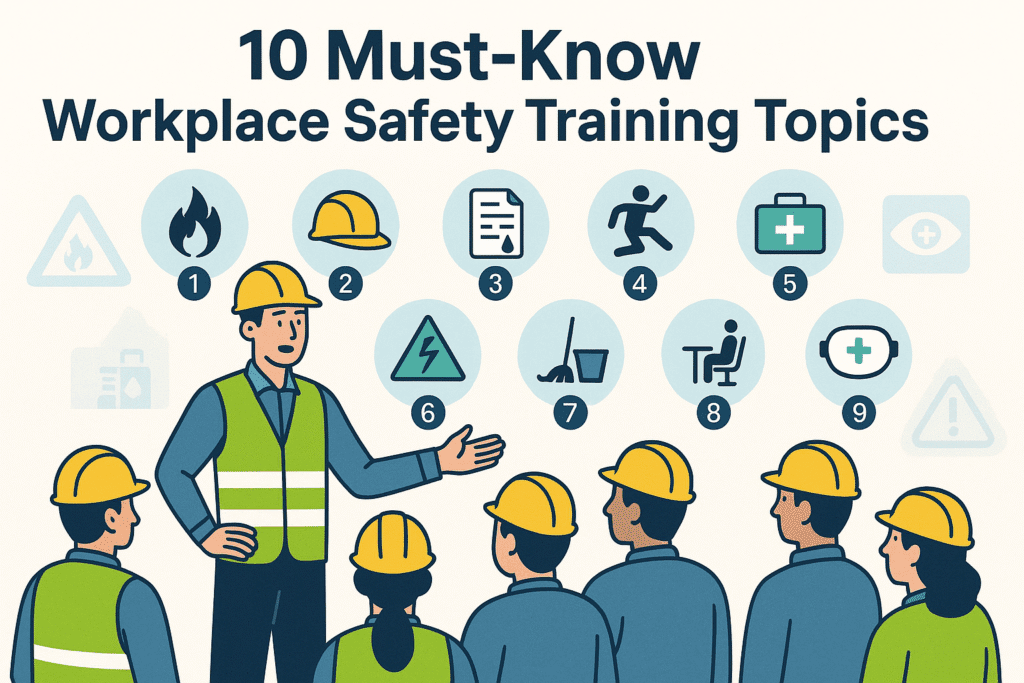
10 Must-Know Workplace Safety Training Topics for Every Employee
Workplace safety is everyone’s responsibility — but employees need the right knowledge to fulfill it. Well-planned Workplace Safety Training Topics reduce accidents, improve compliance, and build a stronger safety culture.
This article highlights 10 Must-Know Workplace Safety Training Topics that every employee, regardless of industry, should learn to stay safe and productive.
1. General Workplace Safety Awareness
Every safety program should begin with a broad overview of workplace safety rules:
- Company health and safety policies.
- Roles and responsibilities of employees and supervisors.
- How to report hazards and incidents.
Example: An office employee learns how to identify tripping hazards, while a warehouse worker learns about safe lifting zones.
2. Fire Safety and Emergency Evacuation
Fires can occur in any workplace. Training should cover:
- Fire prevention measures.
- Alarm signals and evacuation routes.
- Use of fire extinguishers and emergency equipment.
- Assembly points and headcounts.
Tip: Conduct mock fire drills quarterly to reinforce learning.
3. Hazard Communication (Chemical Safety)
Employees must understand the risks of chemicals they handle:
- Reading and understanding Safety Data Sheets (SDS).
- Labeling requirements and hazard pictograms.
- Proper storage, handling, and disposal of chemicals.
- Spill response and emergency contacts.
Example: Lab technicians practice identifying correct PPE for corrosive substances.
4. Personal Protective Equipment (PPE)
PPE is often the last line of defense. This module teaches:
- Selection and correct use of PPE.
- Fit testing for respirators and hearing protection.
- Maintenance, storage, and replacement schedules.
- Limitations of PPE.
Interactive Idea: Have employees practice putting on and taking off PPE properly.
5. Electrical Safety
Electricity is a hidden hazard in many workplaces. Training should include:
- Recognizing live circuits and lockout/tagout basics.
- Safe use of extension cords and portable tools.
- Reporting frayed cables or exposed wires.
- Avoiding water contact near electrical sources.
Example: Maintenance staff demonstrate isolating equipment before servicing.
6. Slips, Trips, and Falls Prevention
One of the most common workplace injuries is from slips and falls:
- Housekeeping practices to keep walkways clear.
- Proper footwear and floor mat placement.
- Reporting uneven flooring or spills immediately.
- Ladder safety basics.
Tip: Use real photos of hazards in your facility to drive the point home.
7. Ergonomics and Manual Handling
Ergonomic injuries build up over time. This topic covers:
- Correct lifting, carrying, and pushing techniques.
- Adjusting chairs, screens, and tools to fit the user.
- Recognizing signs of repetitive strain injuries.
- Requesting ergonomic assessments.
Example: Office staff learn proper keyboard positioning; warehouse staff practice team lifting.
8. Incident Reporting and Investigation
Prompt reporting prevents recurrence. Employees should know:
- Difference between a near-miss, unsafe act, and accident.
- How to complete an incident report form.
- Importance of root cause analysis.
- Confidentiality and non-retaliation policies.
Tip: Encourage a “no blame” culture to increase reporting.
9. Workplace Violence and Harassment Prevention
Safety is not only physical. This training teaches:
- Recognizing early warning signs of conflict.
- De-escalation techniques.
- Reporting harassment or bullying.
- Accessing employee assistance programs (EAP).
Example: Role-play scenarios on how to handle aggressive customers.
10. First Aid and Medical Emergencies
Even if a workplace has trained first aiders, all employees should know basics:
- Location and contents of first aid kits.
- How to call emergency services.
- Basic wound care and CPR awareness.
- Recognizing life-threatening conditions (e.g., heart attack, stroke).
Tip: Offer voluntary certified first aid training to interested employees.
Putting It All Together
By covering these 10 Must-Know Workplace Safety Training Topics, you ensure:
- Legal Compliance: Meets OSHA/NEBOSH/ISO 45001 requirements.
- Accident Prevention: Employees recognize hazards and act proactively.
- Stronger Safety Culture: Everyone participates in keeping the workplace safe.
Additional Tips for Effective Training
- Use Multiple Formats: Blend classroom, e-learning, and hands-on practice.
- Assess Understanding: Quizzes and demonstrations confirm learning.
- Refresh Regularly: Update training annually or when hazards change.
- Track Progress: Maintain training records for compliance and audits.
Benefits of Must-Know Safety Training Topics
- Fewer Incidents: Knowledge leads to safer behavior.
- Improved Morale: Employees feel valued and protected.
- Reduced Costs: Fewer injuries mean lower insurance premiums and downtime.
- Better Reputation: Clients and regulators see your commitment to safety.
Key Takeaways
Workplace safety training is not optional — it’s essential.
By implementing these 10 Must-Know Topics, you empower employees to protect themselves, their coworkers, and your organization’s success.
Suggested Internal & External Links
- External link: OSHA Training Requirements
- Internal link: 7 Essential Safety Induction Training Modules for New Employees
- Crane, Lifting & Rigging Safety Training
- Slips, Trips, and Falls Prevention Safety Training
- Oil and Gas Site Safety Training
- Confined Space Entry Procedures Safety Training
Frequently Asked Questions
1. Why are workplace safety training topics important?
They equip employees with the knowledge to prevent accidents, comply with laws, and respond effectively to hazards.
2. How often should these safety topics be refreshed?
At least annually, or whenever there’s a change in processes, equipment, or regulations.
3. Do all employees need training in all 10 topics?
Yes — though depth may vary by job role, all employees should have at least baseline knowledge of each area.
4. How can companies make safety training engaging?
Use interactive methods: hands-on practice, videos, real-life case studies, and gamified quizzes.
5. Is safety training mandatory?
Yes. In most jurisdictions (OSHA in the US, NEBOSH/ISO frameworks globally), employers are legally required to train employees on workplace hazards.